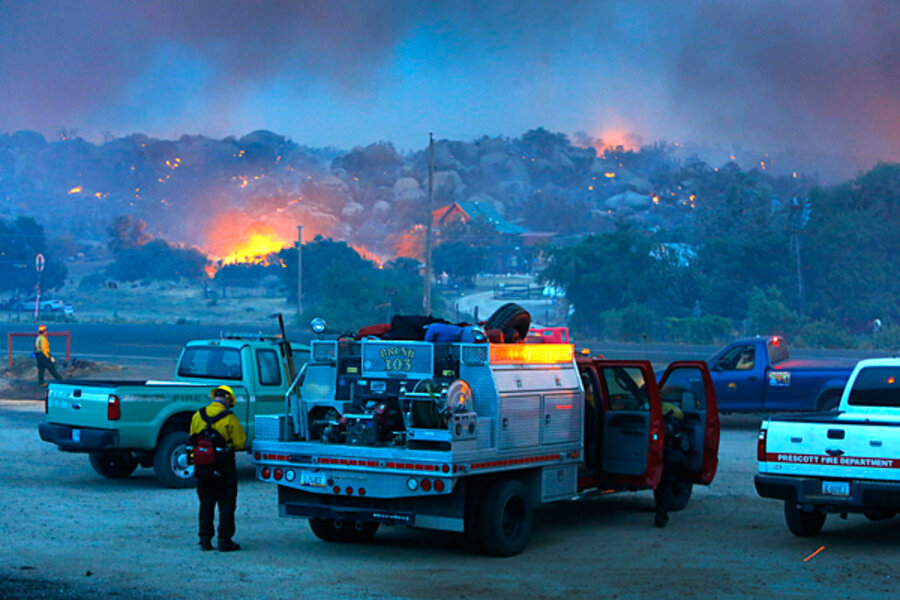19 firefighters killed in Arizona wildfire: What went wrong?
Loading...
The members of an elite firefighting crew who died in Arizona Sunday were overtaken by a fast-moving fire that was thought to be sparked by lightning, as triple-digit temperatures have gripped the US West.
Nineteen members of the “Granite Mountain Hotshots” were killed, said Mike Reichling, Arizona State Forestry Division spokesman, on Monday. More firefighters died battling this wildfire than have died fighting any other wildfire in the United States in 80 years.
"We grieve for the family. We grieve for the department. We grieve for the city," Prescott (Ariz.) Fire Chief Dan Fraijo said at a news conference Sunday evening.
The specially trained “Hotshot Crew” was based in Prescott, about 100 miles north of Phoenix. The 20-member crew was one of 110 Hotshot Crews in the United States, according to the US Forest Service website. Hotshot Crews are often deployed soon after a fire breaks out and will sometimes hike for miles into the wilderness with chain saws and backpacks filled with heavy gear to build lines of protection between people and fires. They remove brush, trees, and anything that might burn in the direction of homes and cities. This crew had worked other wildfires in recent weeks in New Mexico and Arizona.
As a last-ditch effort at survival, Hotshot crew members are trained to dig into the ground and cover themselves with a tentlike shelter made of fire-resistant material, Chief Fraijo said. The hope in that desperate situation is that the fire will burn over them and they will survive.
"It's an extreme measure that's taken under the absolute worst conditions," Fraijo said.
Nineteen fire shelters were deployed, and some of the firefighters were found inside them, while others were outside the shelters, Mr. Reichling told The Arizona Republic.
The National Fire Protection Association (NFPA) website lists the last wildland fire to kill more firefighters as the 1933 Griffith Park fire of Los Angeles, which killed 29. The most firefighters – 340 – were killed in the 9/11 terrorist attacks in New York, according to the website.
The news comes just a few weeks after the NFPA released a study showing the number of on-duty firefighter deaths has actually dropped by more than a third in the past three decades and had fallen to historic lows the past two years. The drop is largely due to improvements to firefighter equipment, better safety standards, and a decrease in overall fires.
A total of 64 on-duty firefighters died in the US in 2012, marking the second consecutive year that the total has been below 65 deaths, the lowest level since statistics began to be tracked in 1977.
Wildfire deaths are included in the annual NFPA reports, but they don’t typically account for a major portion of the deaths, according to an interview with Ken Willette, a former fire chief in Massachusetts and manager of Public Fire Protection at NFPA, when the recent report was released.
In 2012, four members of the North Carolina Air National Guard died when their aircraft crashed while responding to a wildfire in South Dakota, the report says.
The top cause of death for firefighters is listed as cardiac arrest, which has industry associations promoting major health and fitness campaigns.
Wildfire crews have long had strict fitness standards, higher than most fire departments', Mr. Willette says.
Firefighters in the Prescott crew were required to take an 80-hour critical training course and then an annual refresher and were also offered fire-safety courses, according to the crew's website.
Each firefighter had to pass a test of carrying a work pack, as well as run 1.5 miles in 10 minutes, 35 seconds, and complete 40 sit-ups in 60 seconds, 25 push-ups in 60 seconds, and between four and seven pull-ups (based on weight), Reuters reports.
"It had to be a perfect storm in order for this to happen. Their situational awareness and their training was at such a high level that it's unimaginable that this has even happened," Prescott Fire Department spokesman Wade Ward told NBC's "Today" program.
On Sunday the fire, which spread to at least 2,000 acres, also destroyed 200 homes and sent hundreds fleeing from Yarnell, Ariz., a town of about 700 residents about 85 miles northwest of Phoenix.
Eighteen Hotshot Crews are now battling the blaze, and more are expected, Reichling said Monday.
• Material from The Associated Press was used in this report.








